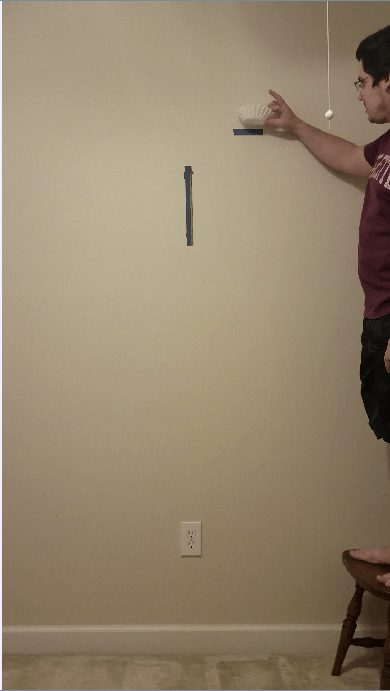Luther Daigle
A Fundamental Study of the Physics Behind Free-Fall
Submitted to Dr. Sithy Maharoof for Physics 1 for Scientists and Engineers (PHYS-111)
Summary:
The purpose of this lab is to study the relationships between mass and air resistance as they interact on a free-falling coffee filter. The goal is to gather sufficient data to show how mass and air resistance affect the time it takes to fall to the ground and at what point the coffee filter attains terminal velocity.
General Education Connections
- Communicate ideas in written, oral and other modes as appropriate to a situation and audience
- Apply quantitative and scientific reasoning skills relevant to a field of study
- Evaluate sources of information for accuracy, relevance and reliability
- Explore issues through creative, interdisciplinary and innovative approaches.
As far as meeting the general education guidelines, I believe that this experiment has gone above and beyond to ensure that Carroll Community College students are getting the absolute best out of their time and education. As a student who is coming back into the college system a second time around after already receiving a Bachelor’s in Business Management five years prior, I cannot stress the importance of well-versed and well-practiced written and oral communication skills in the working world. I believe that this signature assignment is an excellent way to get students as much practice with submitting and presenting assignments like this. This report also forced both me and my fellow students to have to think outside the box to fully grasp the physics behind what goes on during free fall. Through the help of my professor and the numerous hours spent scouring through the material to discern the relevant and accurate information, I am proud to say that I have a competent understanding of the forces behind this incredible phenomenon.
Challenges
The only challenge not able to be fully overcome ended up being the coffee filters reaching terminal velocity. The first set of data suggests it came the closest, but as more weight was added, the graphs quickly started to level off less and less. Given the chance to retry this experiment, it would behoove this experiment to drop the coffee filters from 3 or 4 meters as opposed to only 2 meters. This would allow the remaining coffee filters to attain a true terminal velocity that could easily be seen on the graphed data.
Application
As a future mechanical engineer, the knowledge provided in this study will provide crucial experience. Given the opportunity to work for NASA on space projects as a mechanical engineer, the understanding of objects in free fall is crucial to helping us get off this planet. One project I am particularly interested in is NASA’s reusable rocket boosters. As a booster free falls towards the earth, an engineer must know the effects that weight and drag will have as it re-enters the earth’s atmosphere. It is also an area that cannot afford any miscalculations. Precision and accuracy are key because they determine whether the rocket lands safely or becomes a multimillion-dollar mistake that literally goes up in flames. This knowledge will become extremely useful given the chance to work on projects of that nature.
Additional Media
